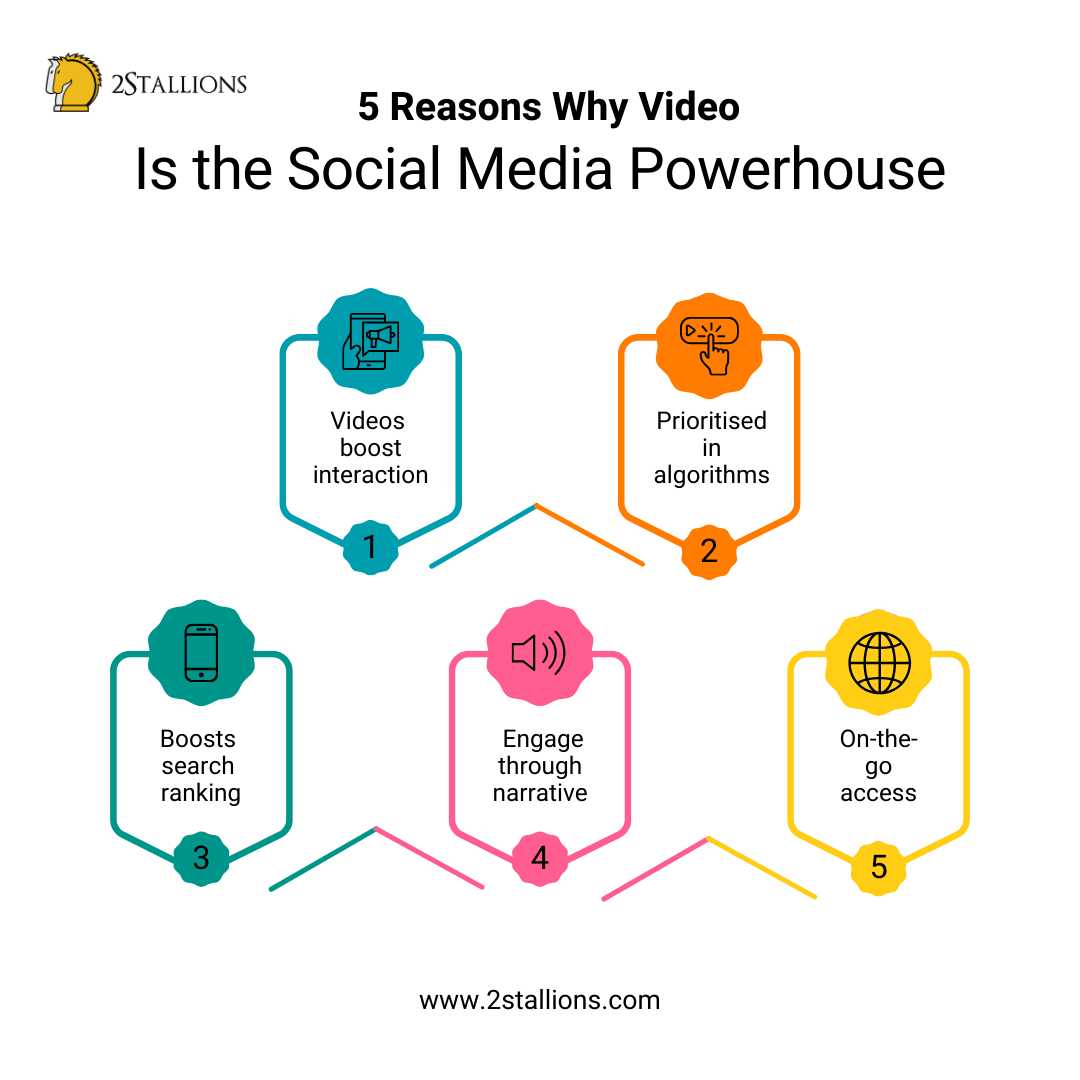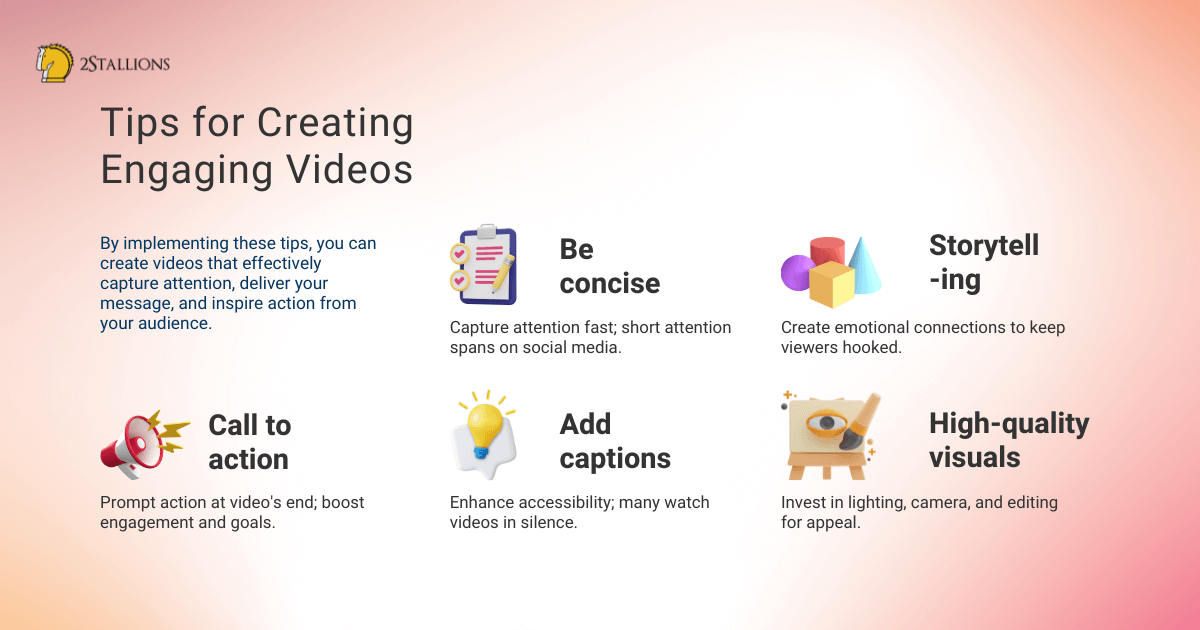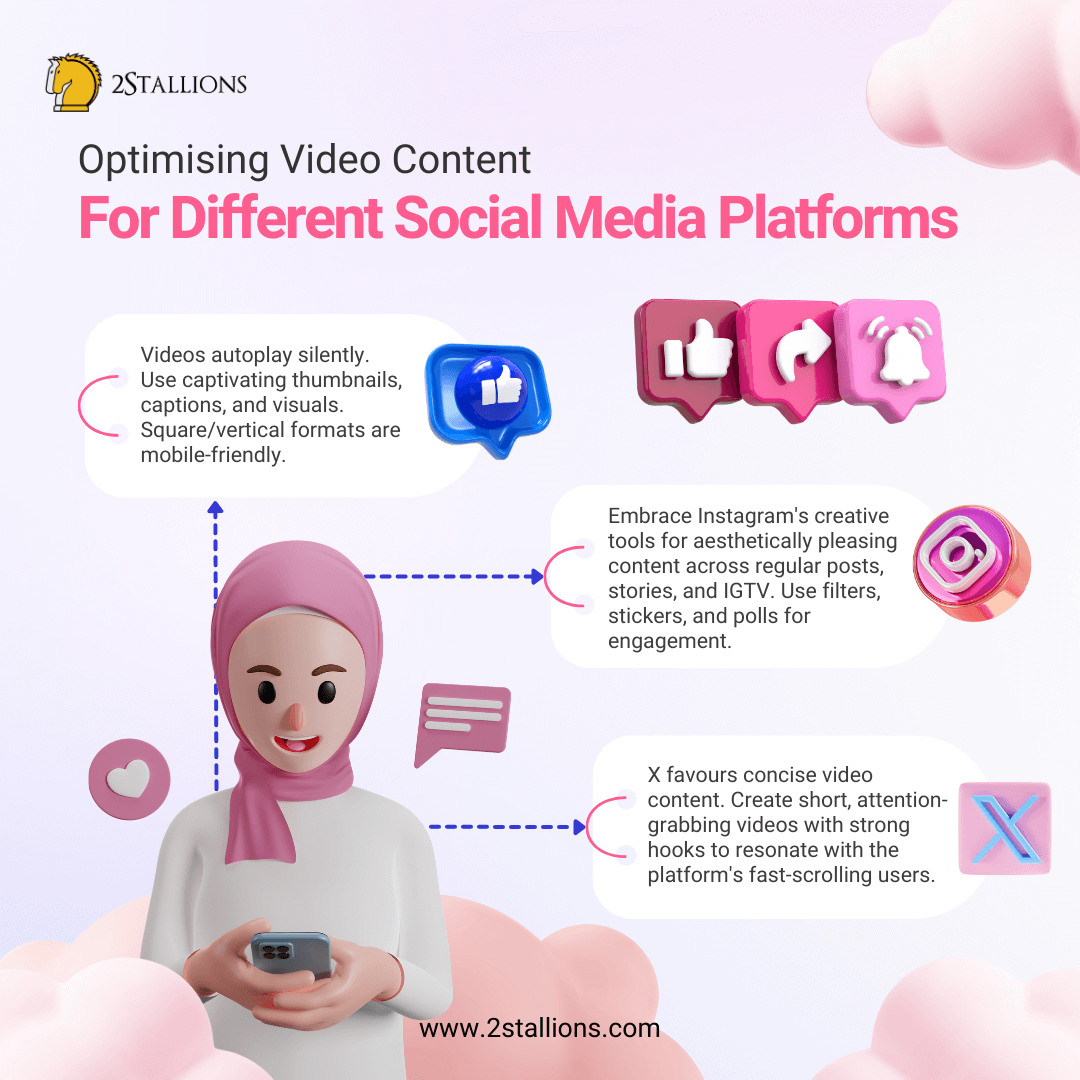SHARE

Video content has become a vital component of a successful social media strategy. With the rise of platforms like Facebook, Instagram, and YouTube, incorporating videos into your social media marketing can help you stand out from the crowd.
In this article, we will explore the importance of video content in social media, discuss how it can boost engagement, and provide actionable tips on crafting compelling videos.
Understanding the Importance of Video Content in Social Media
In today’s digital landscape, video has emerged as a powerful medium for capturing people’s attention. With its ability to convey information succinctly and evoke emotions, video content can potentially engage users in ways that text or static images simply cannot.
As a result, social media algorithms now prioritise video content, making it more likely to be seen and shared by users.
Moreover, video content has a higher chance of going viral, creating buzz and increasing brand exposure. It has tremendous potential to boost brand awareness, drive website traffic, and generate leads or sales.
By leveraging video content effectively, businesses can tap into the immense power of social media to reach their target audience.
Did you know that according to a recent study, videos on social media receive 1200% more shares than text and image posts combined? This staggering statistic highlights the incredible impact that video content can have on social media engagement.
People are naturally drawn to moving visuals and are more likely to share videos with their friends and followers, extending the reach of your brand.
Furthermore, video content allows businesses to showcase their products or services. Whether it’s a demonstration of how to use a product or a virtual tour of a physical location, videos provide a more immersive and interactive experience for viewers.
This hands-on approach not only captures attention but also helps potential customers visualise themselves using your offerings, increasing the likelihood of conversion.
The Role of Video Content in Digital Marketing
In today’s digital marketing landscape, video has become a cornerstone of successful campaigns. It allows businesses to convey their brand message in a dynamic and memorable way, making a lasting impression on their audience.
Whether it’s an explainer video, a behind-the-scenes look, or a testimonial, video content can capture attention and create a meaningful connection with viewers.
Imagine this scenario: you stumble upon a social media post that features a captivating video showcasing a product you’ve been considering purchasing.
As you watch the video, you not only learn about the product’s features and benefits but also see how it can improve your life. This emotional connection created through video content can significantly influence your purchasing decision, making you more likely to choose that brand over its competitors.
Moreover, video content allows businesses to demonstrate their expertise and thought leadership in their respective industries.
You can establish yourself as a trusted source of knowledge and build credibility among your target audience by sharing educational or informative videos. This can lead to increased trust and loyalty from your audience, ultimately resulting in higher conversions and customer retention.
How Video Content Boosts Social Media Engagement
Video content not only catches the eye, but it also holds attention for longer periods. Users watching a video are more likely to stay on your page, increasing their engagement with your brand. This extended engagement sends positive signals to social media algorithms, boosting your organic reach and visibility.
Furthermore, videos have a higher chance of being liked, shared, and commented on by users. This active participation not only increases your brand exposure but also generates valuable user-generated content, providing social proof and building credibility for your business.
With the rise of live videos and stories, social media platforms have provided even more opportunities for businesses to engage with their audience. Going live or sharing behind-the-scenes clips can create a sense of authenticity and build a personal connection with your followers.
Additionally, interactive video content, such as polls or quizzes, can encourage active participation from your audience.
You can foster community and encourage viewers to share their opinions and experiences by incorporating interactive elements into your videos. This boosts engagement and provides valuable insights into your target audience’s preferences and interests.
The importance of video content in social media cannot be overstated. Its ability to capture attention, evoke emotions, and create meaningful connections makes it a valuable tool for businesses looking to enhance their digital marketing efforts.
By leveraging the power of video, businesses can boost engagement, increase brand exposure, and ultimately drive conversions and customer loyalty.
Defining Your Video Content Strategy
Before diving into video production, it’s crucial to define your objectives and identify your target audience. Doing so allows you to tailor your video content to meet their needs and your business goals.
Creating a successful video content strategy requires careful planning and consideration. It’s not just about producing videos for the sake of it; it’s about creating valuable and engaging content that resonates with your audience.
When defining your video content strategy, it’s essential to take into account various factors, such as your brand identity, industry trends, and the preferences of your target audience. By understanding these elements, you can create videos that capture attention and deliver your message effectively.
Setting Clear Objectives for Your Video Content
Start by determining what you want to achieve with your video content. Are you aiming to increase brand awareness, drive traffic, generate leads, or educate your audience? Defining clear objectives will guide your video production and enable you to measure your success later.
Once you have established your objectives, setting realistic goals and defining key performance indicators (KPIs) that align with your objectives is important. This will allow you to track and evaluate the effectiveness of your video content strategy.
For example, if your objective is to increase brand awareness, you may set a goal to reach a certain number of views or shares on social media platforms. If your objective is to generate leads, you may track the number of conversions or sign-ups that result from your videos.
Setting clear objectives and measurable goals ensures that your video content strategy is focused and effective.
[thrive_leads id=’8334′]
Identifying Your Target Audience
Understanding your target audience is crucial for creating video content that resonates with them. Conduct market research to gain insights into their demographics, interests, and pain points. This will help you craft videos that address their needs and interests, increasing the chances of engagement and conversion.
When identifying your target audience, it’s important to consider factors such as age, gender, location, and socio-economic background. By understanding these demographics, you can create videos tailored to their preferences and resonating with their experiences.
Additionally, by identifying your target audience, you can choose the most appropriate social media platforms to distribute your videos. Each platform has its own unique audience and content format, so tailoring your videos accordingly will maximise their impact.
For example, if your target audience consists mainly of young adults, platforms like Instagram and TikTok may be more effective in reaching them. On the other hand, if your target audience is professionals in a specific industry, platforms like LinkedIn and YouTube may be more suitable.
Understanding your target audience and selecting the right distribution channels ensures that your video content reaches the right people at the right time.
Crafting Compelling Video Content
Once you have a clear strategy in place, it’s time to dive into video production. Here are some tips to help you create engaging videos that captivate your audience.
Tips for Creating Engaging Videos
- Keep it concise: Attention spans are short on social media, so aim to deliver your message within the first few seconds. Grab your audience’s attention and make every second count.
- Tell a story: Stories have a unique power to captivate and engage viewers. Use storytelling techniques to create an emotional connection and keep your audience hooked till the end.
- Add captions: Many viewers watch videos on social media without sound. Adding captions ensures your message gets across even in silent mode, increasing engagement and accessibility.
- Use high-quality visuals: Invest in good lighting, camera equipment, and editing software to create visually appealing videos. Quality visuals not only enhance the viewing experience but also reflect positively on your brand.
- Include a call to action: At the end of your video, prompt your viewers to take a specific action, such as liking, sharing, or visiting your website. A clear call to action encourages engagement and helps you achieve your objectives.
By implementing these tips, you can create videos that effectively capture attention, deliver your message, and inspire action from your audience.
Now, let’s delve deeper into each of these tips to gain a better understanding of how they can elevate your video content.
- Keep it concise: In today’s fast-paced digital world, it’s crucial to grab your audience’s attention within the first few seconds. People are constantly scrolling through their social media feeds, and if your video doesn’t captivate them immediately, they’ll move on to the next piece of content. Keeping your videos concise and to the point ensures that your message is delivered effectively and efficiently. Remember, less is often more when it comes to engaging your audience.
- Tell a story: Humans are wired to connect with stories. Whether it’s a heartwarming tale or an exciting adventure, stories can evoke emotions and create a lasting impact on your viewers. By incorporating storytelling techniques into your videos, you can create a narrative that resonates with your audience and keeps them engaged until the end. Consider the hero’s journey or the power of relatable characters to craft a compelling story that leaves a lasting impression.
- Add captions: With the rise of autoplay videos on social media platforms, many viewers watch videos without sound. To ensure that your message gets across even in silent mode, it’s essential to add captions to your videos. Captions not only make your content accessible to a wider audience, including those with hearing impairments, but they also grab attention and increase engagement. Additionally, captions can be used creatively to emphasise key points or add a touch of humour to your videos.
- Use high-quality visuals: Visual appeal plays a significant role in capturing your audience’s attention and conveying your brand’s professionalism. Investing in good lighting, camera equipment, and editing software can make a world of difference in the quality of your videos. Crisp and clear visuals not only enhance the viewing experience but also reflect positively on your brand’s image. Whether it’s a product demonstration or a behind-the-scenes glimpse, make sure your videos are visually stunning to leave a lasting impression on your viewers.
- Include a call to action: A call to action (CTA) is crucial to any video content. After captivating your audience and delivering your message, it’s essential to guide them towards the next step. Whether it’s encouraging them to like, share, comment, or visit your website, a clear CTA prompts your viewers to take action and engage further with your brand. Ensure your CTA is concise, compelling, and aligned with your objectives. By providing a clear direction, you can maximise the impact of your videos and drive the desired outcomes.
By incorporating these tips into your video production process, you can create compelling and engaging content that stands out in the crowded digital landscape.
Remember, video is a powerful medium that allows you to connect with your audience on a deeper level. So, take the time to plan, create, and refine your videos to ensure they leave a lasting impression and inspire action from your viewers.
Optimising Video Content for Different Social Media Platforms
Each social media platform has its own unique format and user behaviour. To make the most of your video content, tailor it to fit the specific requirements of each platform.
Tailoring Video Content for Facebook
On Facebook, videos autoplay without sound, so it’s crucial to capture attention visually. Use eye-catching thumbnails, engaging captions, and impactful visuals to entice users to click and watch your videos. Additionally, consider creating square or vertical videos to maximise screen real estate on mobile devices.
Making the Most of Instagram’s Video Features
Instagram offers various video features, including regular posts, stories, and IGTV. To stand out on this visual platform, focus on creating aesthetically pleasing videos that align with your brand’s style. Embrace Instagram’s creative tools, such as filters, stickers, and polls, to make your videos more engaging and interactive.
Utilising X-Platform’s Snappy Clips
X Platform, formerly known as Twitter, thrives on succinct, impactful content. Crafting short, attention-grabbing videos is vital to engaging its fast-scrolling user base. Employ compelling hooks and visuals to make an immediate impression. Utilise trending hashtags strategically to boost discoverability and expand your video’s reach in this dynamic and conversation-driven environment.
Measuring the Success of Your Video Content
To assess the effectiveness of your video content strategy, it’s important to track key metrics and analyse analytics regularly.
Key Metrics to Track for Video Content
- Views: Monitor how many users watched your videos to gauge their reach and popularity.
- Engagement: Track likes, shares, comments, and click-through rates to measure how well your videos resonate with your audience.
- Conversion: If your objective is to drive traffic or generate leads, track the number of users who took the desired action after watching your videos.
By analysing these metrics, you can gain valuable insights into what’s working and needs improvement. Use these insights to refine your video content strategy and optimise your future videos for even better results.
Using Analytics to Improve Your Video Content Strategy
Analytics provide valuable data to help you understand your audience’s preferences and behaviours. For example, if you notice that your videos perform better on certain social media platforms or at specific times of the day, adjust your strategy accordingly. Experiment with different formats, topics, and lengths to find the optimal formula for engaging your audience.
Additionally, analysing audience retention rates can help you identify the sections of your videos where users drop off. Use this information to improve your storytelling, pacing, and video structure to keep viewers engaged throughout.
Conclusion
Video content is a powerful tool for engaging and connecting with your audience on social media. By understanding its importance, defining your objectives, and crafting compelling videos, you can create an effective video content strategy that enhances your brand’s visibility, drives engagement, and delivers tangible results.
Regularly measuring and analysing the success of your videos will enable you to refine your approach and continuously improve your social media presence. So, start leveraging the power of video content today to make a lasting impact on your social media audience.









